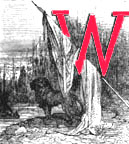 illiam Morris's "King Arthur's Tomb" continues the dramatic situation established in "The Defence of Guenevere." The poem opens in the season of "hot August noon" suggesting a shift away from the young and innocent love associated with springtime and a movement towards a more reflective and mature love associated with autumn and winter. As he rides towards Glastonbury at the beginning of the poem, Launcelot's dazed and confused state of mind contrasts with Guenevere's sharp intellect which enables her to delay her execution in "The Defence of Guenevere." As in "The Defence of Guenevere" when she uses her own beauty to argue her innocence, Guenevere in this poem calls attention to her beauty as the reason Christ should give her grace: "...dost thou reck / 'That I am beautiful, Lord, even as you / And your dear Mother?" (168-171)
illiam Morris's "King Arthur's Tomb" continues the dramatic situation established in "The Defence of Guenevere." The poem opens in the season of "hot August noon" suggesting a shift away from the young and innocent love associated with springtime and a movement towards a more reflective and mature love associated with autumn and winter. As he rides towards Glastonbury at the beginning of the poem, Launcelot's dazed and confused state of mind contrasts with Guenevere's sharp intellect which enables her to delay her execution in "The Defence of Guenevere." As in "The Defence of Guenevere" when she uses her own beauty to argue her innocence, Guenevere in this poem calls attention to her beauty as the reason Christ should give her grace: "...dost thou reck / 'That I am beautiful, Lord, even as you / And your dear Mother?" (168-171)
Launcelot appears lost in a reverie of past glories such as "how Sir Gareth ran / A good course that day under my Queen's eyes," and refuses to acknowledge that his sins have caused the downfall of an empire. Despite her adultery, Sir Lancelot compares Guenevere to the Virgin Mary: When She dwelt upon heaven a while ago, / And ruled all things but God" (65-66 ). Launcelot continues to live in a romantic fantasy world that is now in the past and does not appear to feel any guilt or responsibility for his deeds. Launcelot's memory of how Guenevere would "let (him) lie / And kiss her feet" contrasts with the moment when Guenevere expresses deep contrition for her sins and kisses Christ's feet in the gesture of Mary Magdalene: "'Speak to me, Christ! I kiss, kiss, kiss your feet" (181). Whereas Guenevere has already reflected on the consequences of carnal love and turned to spiritual love as a source of redemption, Launcelot still clings to the idea of earthly, romantic passion. At Arthur's tomb which he at first fails to recognize, Launcelot asks Guenevere to "fling / Your arms and hair about me" (191-192). During their encounter at Arthur's tomb Guenevere remains cold and harsh and repeatedly renounces him. She wants to save him from damnation by causing him to feel guilt and shame instead of lust: "'Christ! my hot lips are very near his brow, / Help me to save his soul! (207-208). In the final scene of the poem, the symbolic stigmatic wounds suggest that Launcelot has been converted to a new moral awareness. Also, the image of Launcelot lying "in a swoon" recalls the deposition from the cross: "How long I lay in swoon I cannot tell: / My head and hands were bleeding from the stone" (395-396).
Questions
1. What is the effect of having stage directions in the poem: "(Launcelot falls)" and "Launcelot on waking"? What does Guenevere mean when she says, "Now I have slain him" (388)? Does Launcelot need to symbolically die in order to be reborn?
2. How does Morris contrast the personalities and moral characters of Guenevere and Launcelot?
3. How do Guenevere's rhetorical strategies in this poem compare with the ones she uses in "The Defence of Guenevere"?
4. What is Morris's mission in writing his own version of this medieval tale? Does the narrator want us to sympathize with these figures?
5. In what ways does Morris's "King Arthur's Tomb" resemble Swinburne's "Laus Veneris"? Which poem saw publication first?
Last modified 7 November 2004